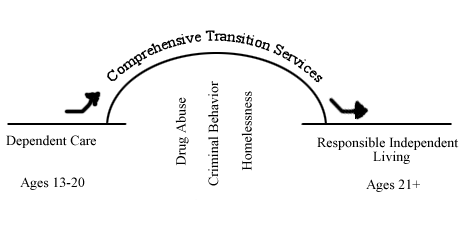transition gap
In the United States, there are increasing numbers of youth who are not being prepared for responsible, independent living by the traditional social-educational system. The gap between residential care and independent living for at-risk youth in non-traditional environments is in need of a bridge.

- In the absence of traditional parent structures, alternative agencies, organizations, and care facilities exist to attempt to meet this population’s basic needs. Presently, these services fall short of the long term needs of these troubled youth’s development continuum.
- In local regions and municipalities, troubled youth are referred to alternative schools and residence treatment programs based on a lack of other placement or support options. These organizations provide housing, education, specialist coordination and follow up field support but do not have bandwidth for transitional programming.
- Youth participants in these programs suffer because they are not able to realize their educational and vocational potential to become independent and productive citizens. In addition, society suffers by paying the price for this inefficiency in the form of continued tax burden for care, increased incidences of crime, and overall unproductive citizens.
- What is needed to eradicate this negative phenomenon is a dedicated development institute and resource portal focused on the educational/vocational development and effective transition of youth from residential care to independent living.
- Since changing the environment in which these youth live is a complex and difficult proposition, guiding and changing the behavior of these youth is an attractive approach.
|



